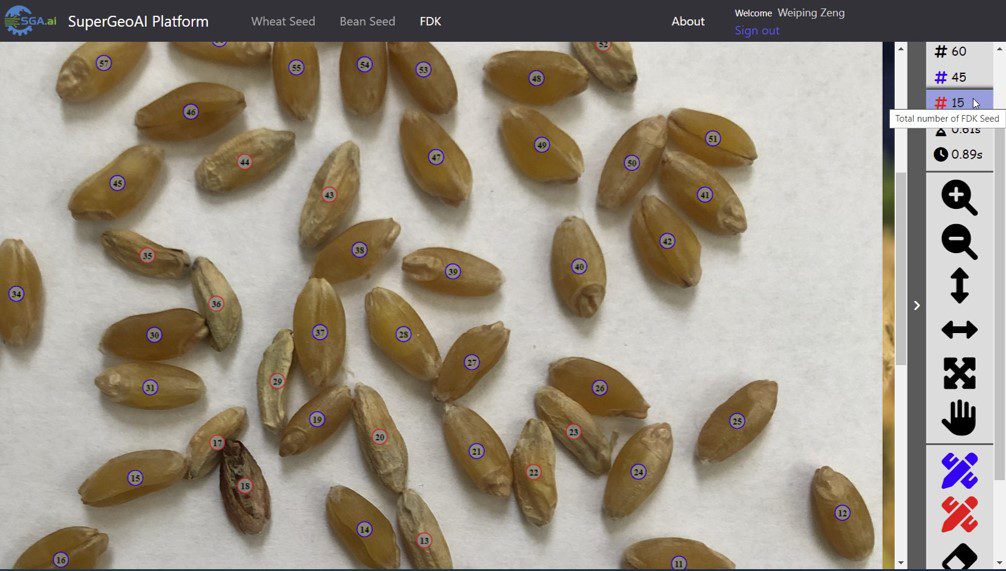
Weiping Zeng, whom we introduced in our story of Phase 1 of GeoAI Platform for Automating Manual Observation Associated with Wheat Production, has done a masterful job of leading the advancement of his team’s wheat evaluation application.
“As we said when we were discussing Phase 1,” Dr. Zeng notes, “Grading is a key element of the grain production value chain. It’s at this moment that farmers find out what all their hard work is going to bring them. It’s as stressful as it is critical to their survival. And when I thought about that, it occurred to me there had to be a way to remove the subjectivity from this process, which would reassure buyer and seller. I imagined a technology that would make grading a purely objective, AI-driven exercise that would increase productivity and decrease workload.”
Phase 1 of the project saw the GeoAI team develop a working prototype of the grain grading app. They were so successful that they were able to proceed directly to Phase 2, which started with launching Android and iOS versions of the software for Canadian and US customers. Several hundred farmers downloaded the app, creating a test market that will allow the developers to employ real-world experiences to guide their progress as they proceed with Phase 2, which, simply put, is to refine the technology and take them closer to a commercially viable product.
The evolution of the second stage will overlap with the start of the third, with a focus on refining the software and working with new partners on necessary hardware, including a precision camera for grain buyers. As things stand now, the application works with a smartphone, which is adequate for farmers seeking a snapshot of their product’s quality, but is not precise enough for buyers who need to know precisely what they are purchasing.
As noted previously, the industry has long sought an affordable solution capable of delivering a quick and accurate end-use quality assessment based on representative samples. Grain inspectors are highly competent professionals, but they are human and susceptible to error and inconsistency, just like everyone else. Assessing the quality, and therefore value, of a broadacre harvest is, therefore, too important not to take advantage of any technology capable of making the process objective, verifiable, and repeatable.
Weiping reflects for moment to summarise how far his team has come in a relatively short period of time. “The CAAIN-funded grain-grading project has been instrumental in the growth and success of Super GeoAI Technology Inc. (SGA). Crucially, CAAIN’s endorsement and funding for the project’s first phase in December 2021 served as a lifeline for us at a time when our future was uncertain. Founded on January 18, 2020, SGA is an Agtech startup that faced a pivotal moment in late 2021.” He pauses, then continues with a smile. “As its founder, I was torn between advancing the venture and seeking stable employment. CAAIN’s support not only bolstered my decision to press forward as an entrepreneur. It also catalysed our remarkable growth, expanding our team to 28 full-time employees within two years and setting a target of 40 by early 2025. Our workforce, predominantly composed of recent graduates and new immigrants, includes 15 individuals who were unemployed before joining SGA, many of whom have now become pivotal to our operations.”
In the first of the project’s three phases, the team of agri-food companies and academic institutions employed diverse technologies to demonstrate a novel geospatial artificial intelligence (GeoAI) platform proof-of-concept that automates manual wheat-production observations. The GeoAI team leveraged geospatial, deep learning, machine vision, and high-performance computing technology to evaluate three representative primary objective characteristics and one subjective characteristic in Canada Western Red Spring Wheat (CWRS) kernels.
Phase 2 will launch commercial applications for wheat producers and grain buyers, with more robust datasets and higher accuracy for five primary objectives (Ergot, Fusarium Damaged Kernels, Hard Vitreous Kernels, Sprout, and Sawfly) and two subjective grading factors (frost/heat stress damage and Green) in CWRS kernels. Phase 3 is being refined.
The project team’s goal is to create and market a scaled-up, all-in-one GeoAI-driven cloud platform that automates numerous agricultural tasks, with a focus on grain grading. This will reduce manual observation requirements, increasing productivity, profitability, sustainability, and competitiveness for Canadian producers, which aligns with CAAIN’s mandate to advance the agri-food sector by supporting advances in automation and robotics, data-driven decision-making, and smart farm platforms.
In Phase 2, GeoAI will expand beyond wheat to include Canola and peas, and expects to begin working with another CAAIN-funded project partner, Saskatoon-based VeriGrain, whose grain sampling technology is also threatening to turn the sector on its ear. Together, these entrepreneurial innovators will integrate their groundbreaking technologies to bring the grain industry into the 21st century and stop relying on inconsistent, subjective approaches to assessing grain value.
CAAIN Contribution
$711,586
Total Project Value
$2,171,259
Project Contact
Weiping Zeng
Super GeoAI Technology
wzeng@sga.ai